projects: cetacean press/quotes bibliography
Inspired by the literary concept of the unreliable narrator and the medieval bestiary, The Unreliable Bestiary is an ark of stories about animals, humans, and planet Earth. With a team of award-winning collaborators, Deke Weaver’s life-long project is presenting a performance for every letter of the alphabet—each letter representing an endangered animal or habitat. 2023’s CETACEAN (The Whale) – The Unreliable Bestiary’s sixth performance – wove dance, sound design, and huge-scale video projection through tales of the sea and its failing ecosystems.
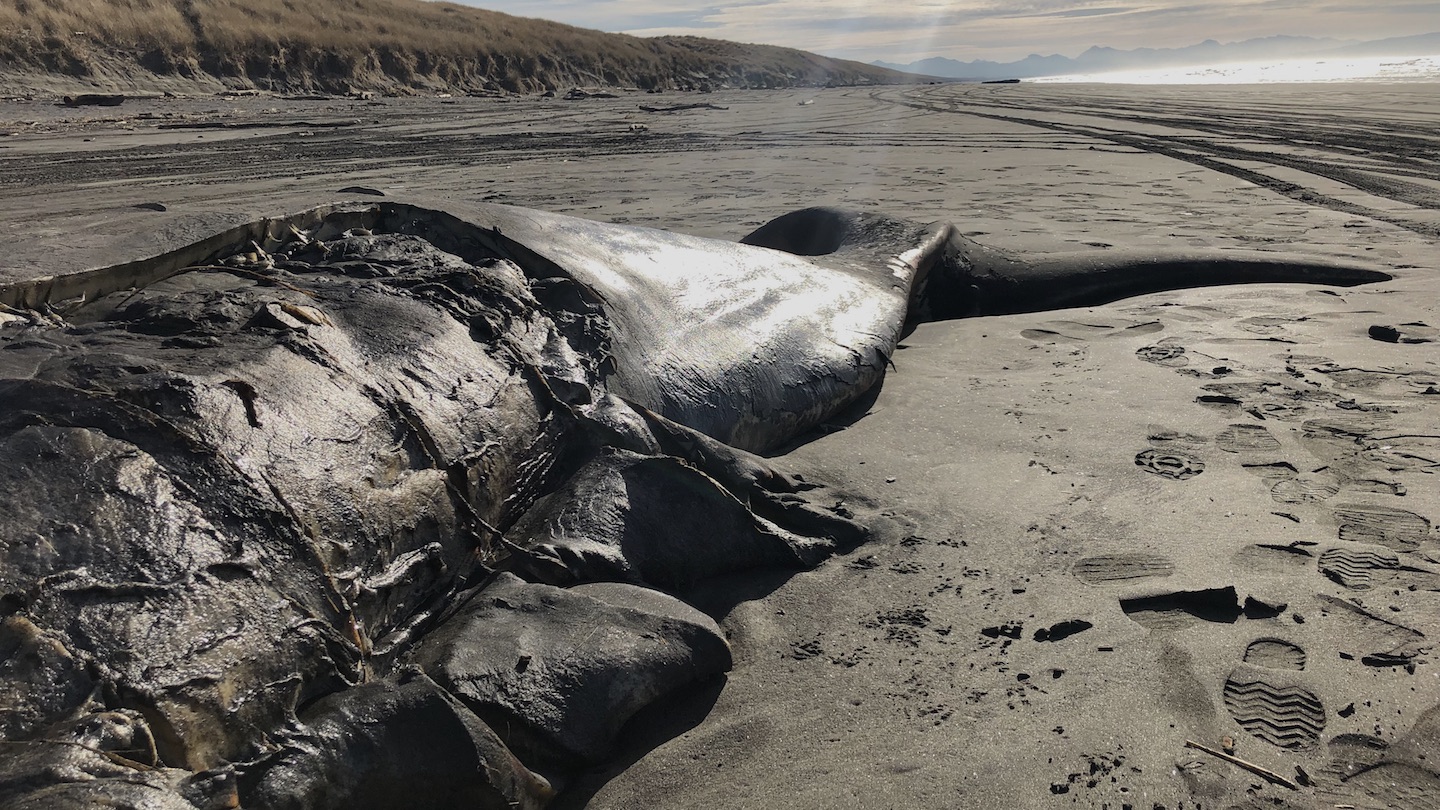
We are putting together a condensed version, a translation of the original CETACEAN, for a Fall 2025 tour. If you have interest in hosting the show, please be in touch.
{ VIDEO TRAILER}
At turns hilarious, mesmerizing, and elegiac, the original CETACEAN (September 28-October 2, 2023) was a gathering of humans – 2,490 people saw the show over it’s five night run – a vast living memorial, an opera without a lot of singing, a haunting waking dream. Can a word-cloud describe a two and a half hour show in a giant stock pavilion? Let’s try: multi-textured, layered, poly-media-ed. Mythic, wry, and absurd. Packed with information, despair, wonder, and hope. High tech. Low tech. Loud and soft. Dazzling and pitch black.
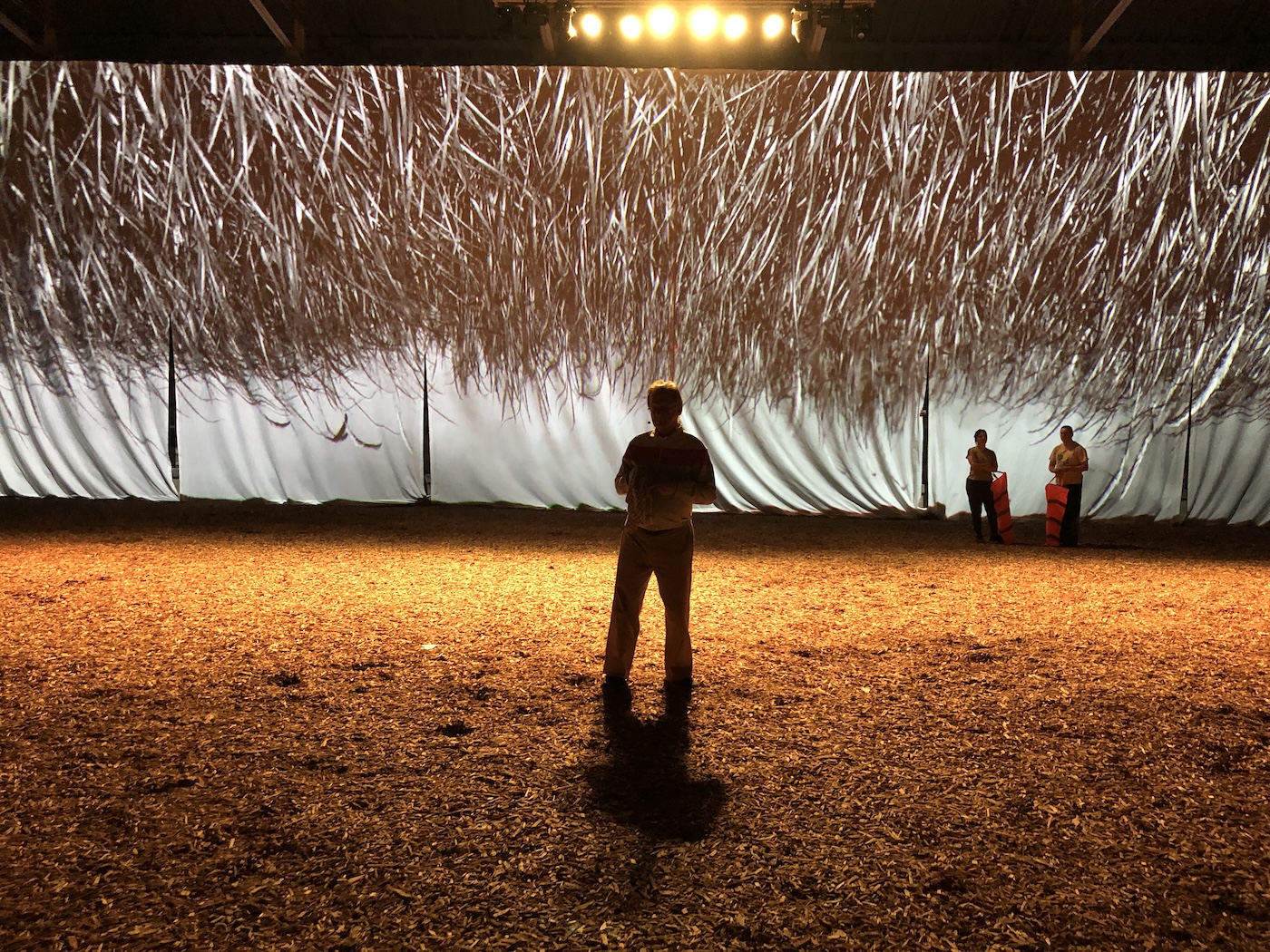
CETACEAN started with this idea: a beached whale can be the equivalent of a Superfund site. Removing 35-75 tons of rotting whale is a problem. The task becomes harder, and even dangerous, when it’s understood that man-made toxins polluting the ocean concentrate in whale blubber. In her book Fathoms: The World in the Whale, author Rebecca Giggs writes, “Greenland’s Inuit women, who seasonally consume whale … had been warned off eating beluga during pregnancy and advised to stop nursing their babies altogether … According to BBC’s ‘Planet Earth: The Future’: ‘If her milk was in containers other than her breasts, she would not be allowed to take it over state lines.’”
Mother’s milk used to be the definition of innocence and purity. We’ve come to a time in human history where it just might kill you.
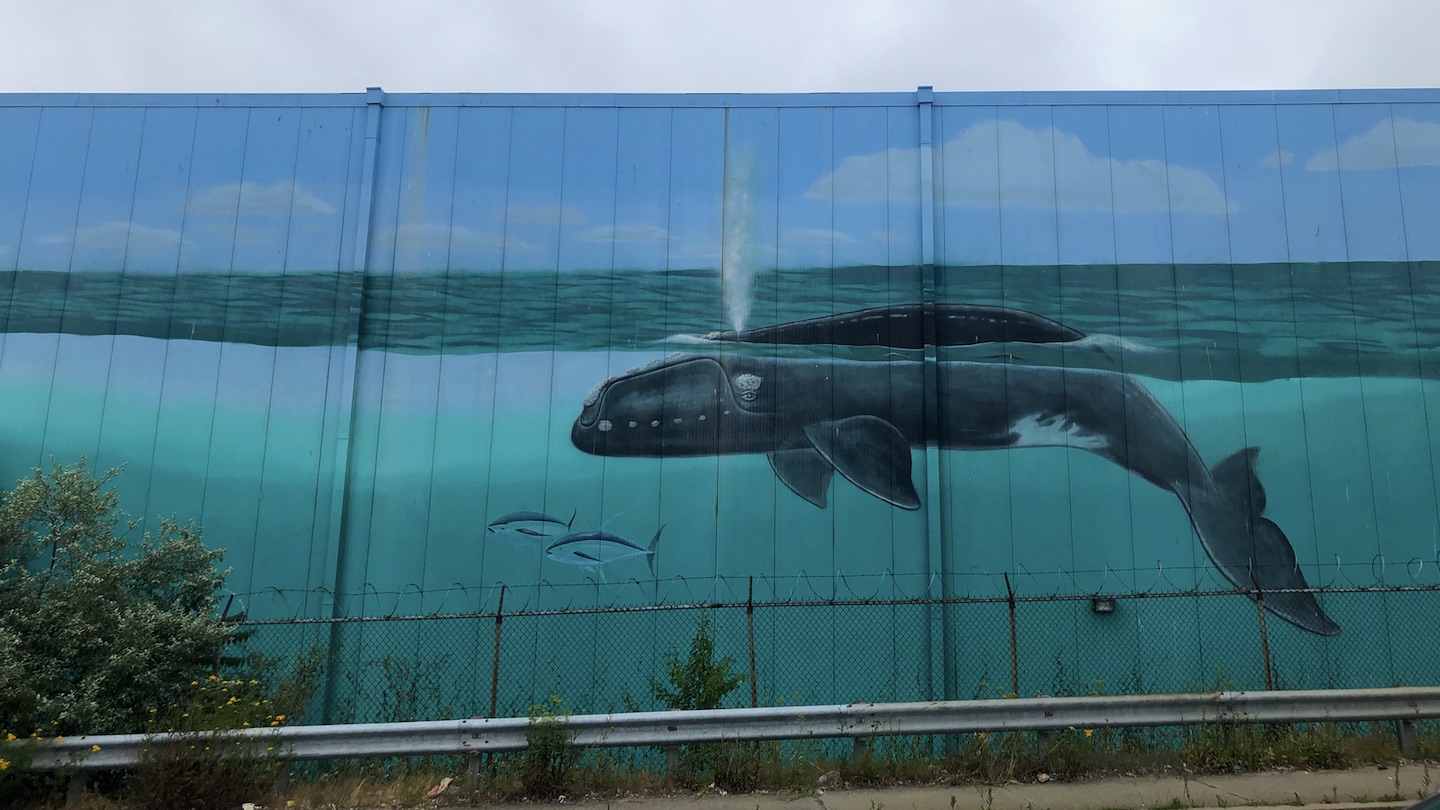
Who made this CETACEAN thing? The Unreliable Bestiary. Here we go …

writer/performer/producer: Deke Weaver
director/choreographer/performer/producer: Jennifer Allen
production design/producer: Andy Warfel
technical director: Blane Friest
costume design: Susan Becker
song: Renée Benson
video design: John Boesche & Deke Weaver
sound design: James Lo
set design: Phil Orr & Melissa Pokorny
puppets: Charles Pascale
lighting design: Rob Perry
dramaturg: Jayne Wenger
performers: Gary Ambler, Latrelle Bright, Laura Chiaramonte, Adanya Gilmore, Gabriel Gonzales, Arthur Hall, David Hays, Jacob Henss, Emmy Lingscheit, Jorge Lucero, Guen Montgomery, Philip Phillips
stage manager: Sidney Sprunger
production manager: Joshua Stenger
CETACEAN (The Whale) was supported by the Student Sustainability Committee, the Arts Community and Research Partnership Program, the Center for Advanced Study, the Humanities Research Institute, the College of Agriculture, Consumer, and Environmental Science, the College of Fine and Applied Arts, the Krannert Center for the Performing Arts, the School of Art & Design, Smile Politely, PYGMALION, CU Adventures in Time and Space, Weaver’s 2021 Illinois Artist Fellowship, with residencies at Centrum and MacDowell.
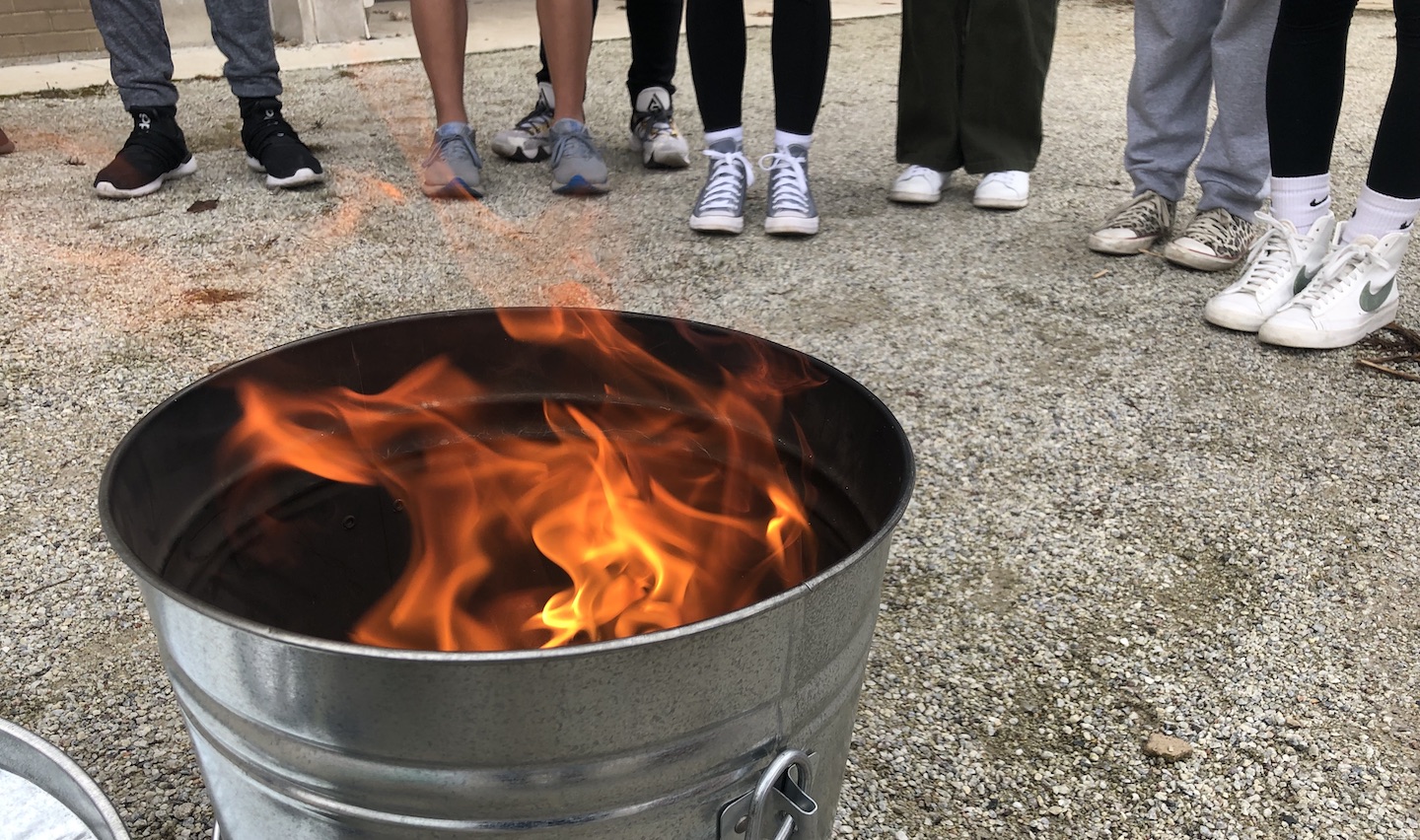
Part social practice, part installation, part live event, the project’s three years of research culminated in a big fat live public performance. For two years, over 800 students in 45 classes listed their hopes and fears in CETACEAN workshops. Students burned the lists of fear, made origami stars from the lists of hope, and filled discarded plastic bottles with the ash of fear and the stars of hope. We suspended thousands of these messages-in-a-bottle in the cavernous University of Illinois Stock Pavilion, and told stories under a sea of hope and fear.
CETACEAN in Progress – 2021-22
CETACEAN in Progress – 2022-23
CETACEAN Work-in-Progress 2021-22
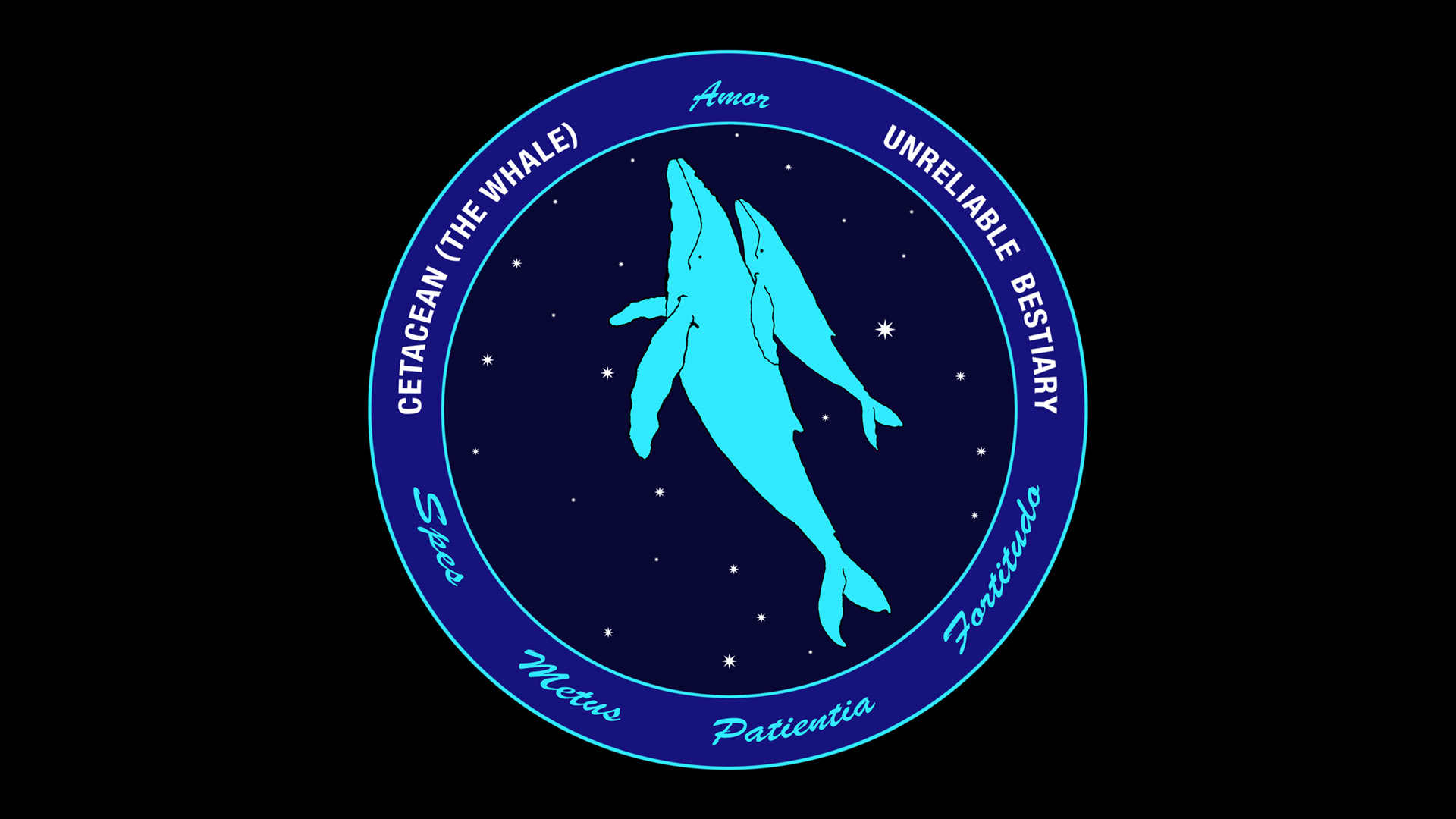
Bestiary performances have had great support from the Urbana-Champaign and University of Illinois communities. 2023’s CETACEAN saw folks come in from a long way – Jen came from London. Eileen came from Cardiff, Wales. Amy, Heidi, Diana, Una, and Hali from New York. Peggy came down from Chicago with her son Ned (from Vermont). Ryan brought his class down from Chicago, and David brought his from DuPage. Jane came from Nova Scotia. Linda and Stephen took the train from Portland, Oregon. Kitty and Dave came from Massachusetts. Bob and Elizabeth from Virginia. Holly and Sally from Michigan. Kim and Meredith from Iowa. Sam from Colorado. Jayne came from California. Wilson and Julia from Pennsylvania. Nicki and Anthony from South Dakota. Shannon from Kansas. And Panos drove up from Kentucky. Thanks for coming, you superstars.
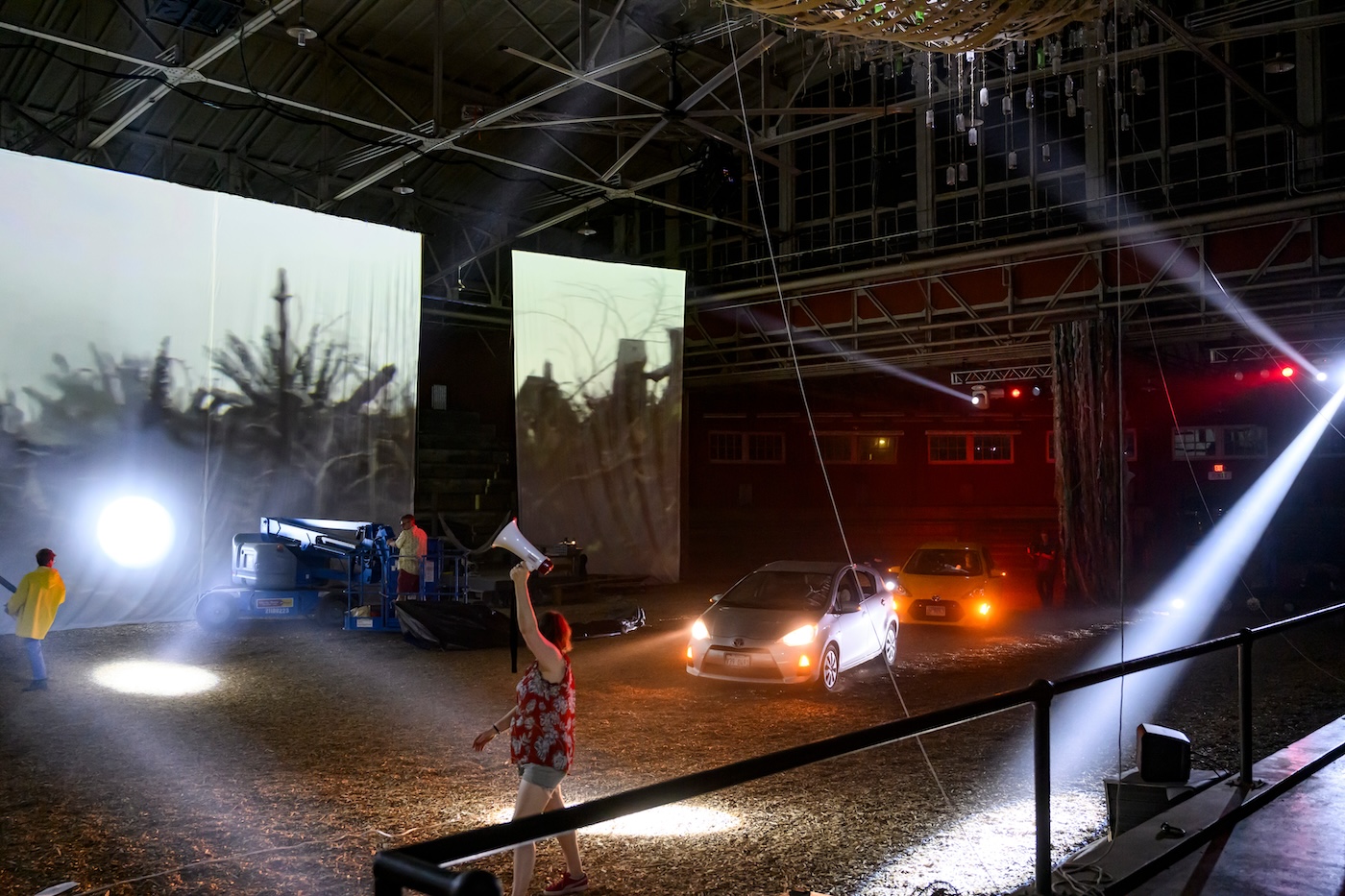
Here are a few excerpts from articles about the show.
“… at the end of the first act, in a callback to information about underwater ocean noise levels increasing, a caravan of honking cars, (a tractor), and people with bullhorns circles the arena, making a truly deafening amount of noise. It was shocking, of course, but it was also an aural kick in the ass reminder that we, humans, have to change our behaviors or we will, in fact, die, and kill all sorts of other life, too. Compared to the delicacy and nuance of the performance, it was heavy handed and, in some ways, obscene, but it was exactly that juxtaposition that made the act-ending caravan incredibly powerful.”
Jessica Hammie, “Listening to Whales in Central Illinois,” Sixty Inches From Center, January 17, 2024

“One after another, different types of whales were produced on screen, to scale. At the same time, someone in the center of the pavilion would hold up a sign with the whale type and how long it is, then five more people would shout out the measurement, and more performers would lay out rope indicating the length along the back screen. It happened quickly and frantically so that you heard: “Orca! Twenty four feet!”, for instance, six times in quick succession from performers scattered throughout the pavilion. The whales were listed from smallest to largest with the final one being the blue whale, coming in at a staggering 95 feet. Watching the progression and that demonstration with the rope was astounding… (leaving) you in awe that such large creatures exist here on earth…”
Serenity Stanton Orengo, “CETACEAN Took You on a Journey to the Bottom of the Ocean,” Smile Politely, October 4, 2023
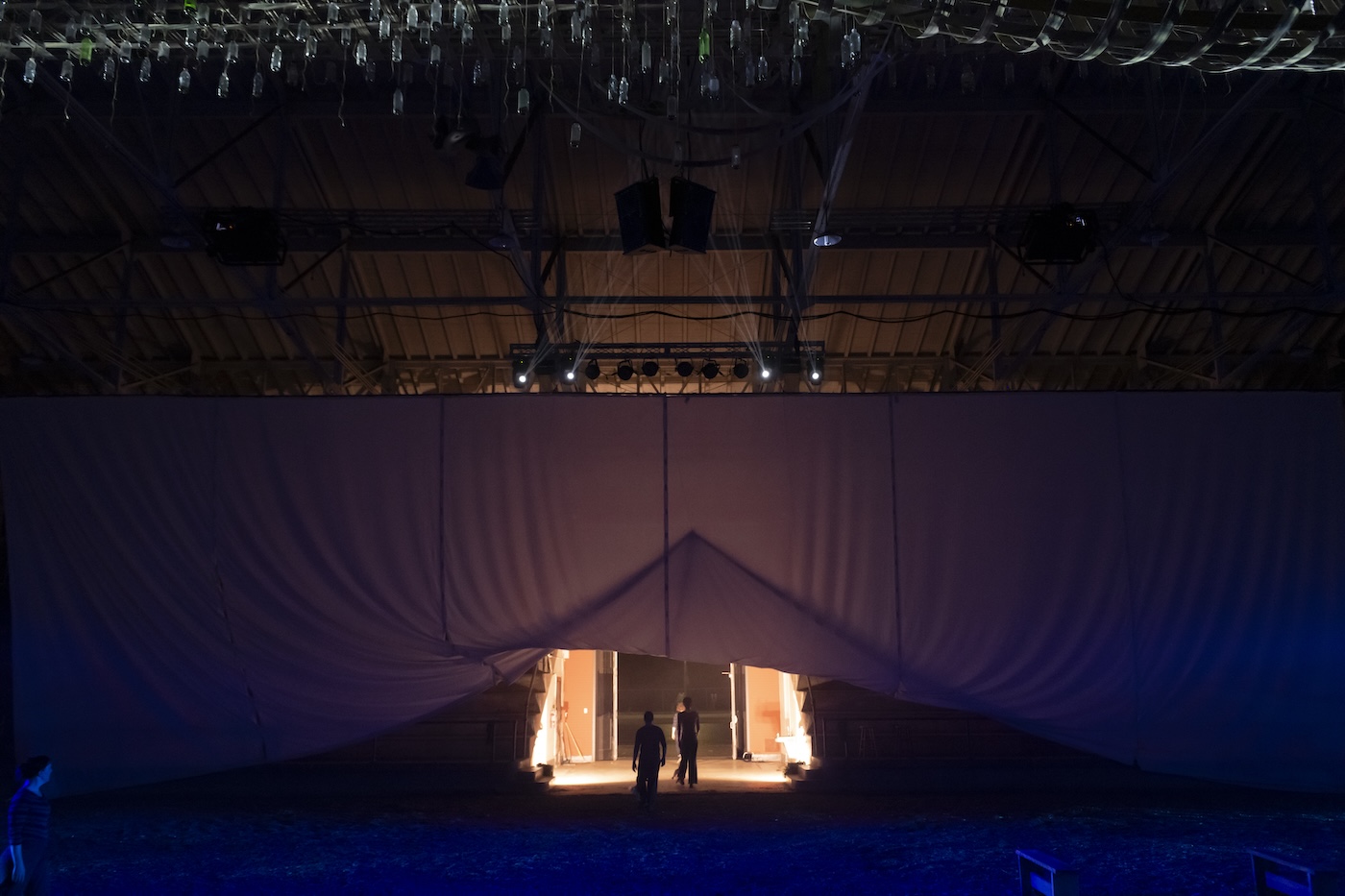
“If a whale fall, from flesh to bones, is a story of building hope upon ruins, the skeleton overhead entails a similar tale. The Cetacean crew collected these bottles from high schoolers in Illinois. In the Cetacean outreach project, these children, though living in a landlocked state, were able to transcribe their hope and fear of the ocean and put them into the bottles. The younger generation reflected on, verbalized, and communicated with each other about their perceptions of the sea. When they come to the performance, they know one of their bottles is hanging from the whaley skeleton. Cetacean, rather than an artwork far away from their life, connects their daily lives to the ocean. The hope and trust in education transformed garbage into a gorgeous stage set.
Cetacean makes the ocean tangible. Through the visual, olfactory, and material remediation of a whale’s corpse, it laments the dire impact of fossil modernity on marine life. The whale skeleton above our head, like an elephant in the room, reminds us how slow violence can be invisible despite the imminent danger of ecological crises. It asks us to rethink our perceptions of and relations to more-than-human lives in all their forms. It writes decomposition into a poem that speaks to the life cycle in nature and a shared fate on planet earth, uttering not only an apology, but also a promise.”
Ann Xiaoxu Pei, “The Art of Decomposition in ‘Cetacean’ and ‘Rendered Obsolete,'” Edge Effects, July 9, 2024.
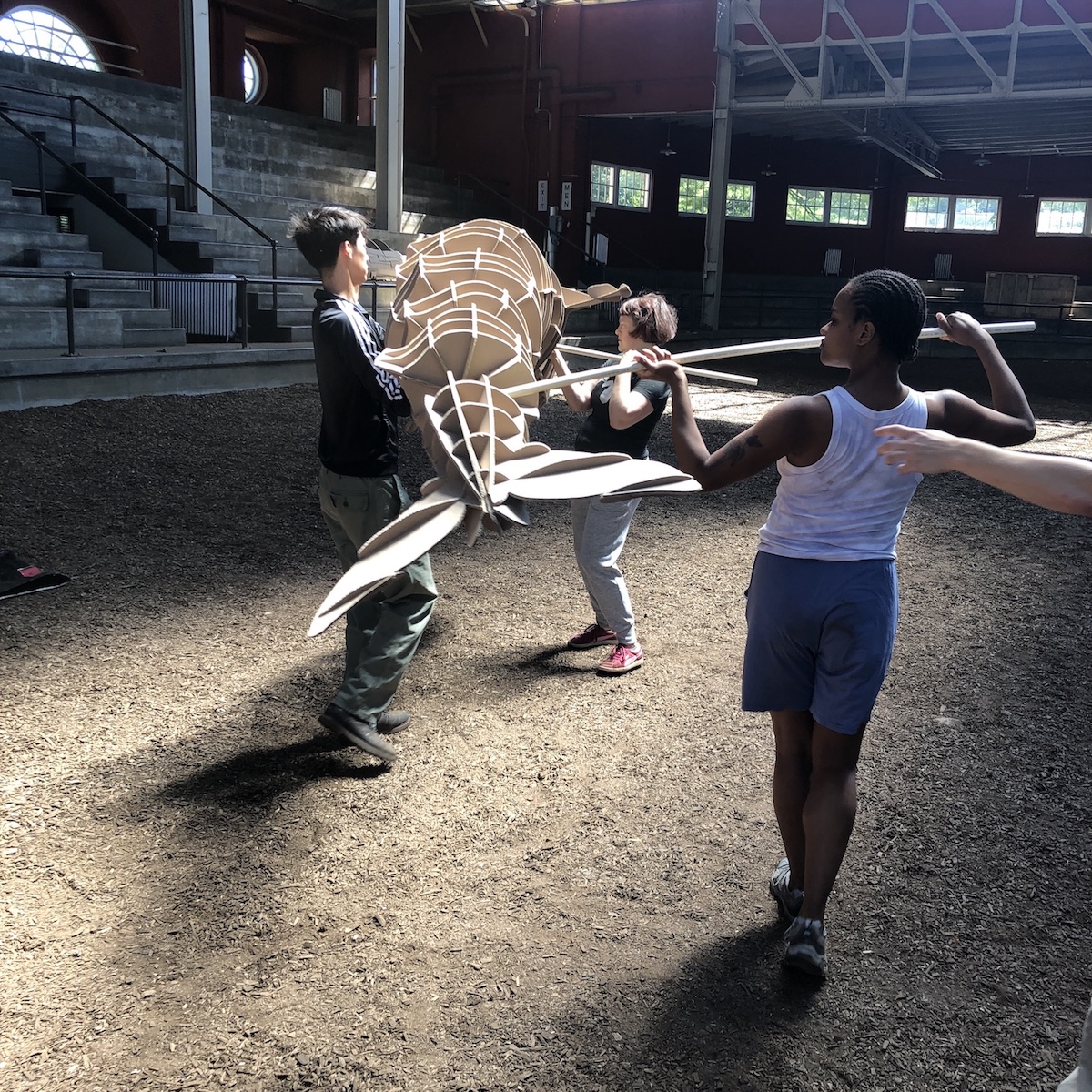
“Throughout the performance Weaver, Allen, and the diverse and inclusive ensemble engage with histories, folk legends, art works, literature, and journalism to present a work that weaves together cultures and histories through media, dance, storytelling, and song. The piece is comprised of multiple sources—versions of ‘Moby Dick,’ personal and historical narratives, scientific facts—asking viewers to think deeply about the lives at stake, both human and nonhuman. One of the most disturbing and impactful moments in the production came after listening to the beautiful score of whale sounds, clicks and songs, which were slowly interrupted by a growing cacophonous chorus of human sounds—car horns, megaphones, chainsaws, drilling, boat engines. This assault to the audience’s ears was followed by a simple statement: that whales have had to change their behaviors and ways of communicating due to increased noise pollution in the oceans. Moments like this in Weaver’s work reiterate a need for species interconnection and provide a haunting and resounding call for a more-than-human future:
‘The gears of an ecosystem’s clockwork include air, water, animals, money, and the human imagination. Our fantasies, assumptions, and cultural mythologies literally shape the land. Animals and their stories are embedded in our environmental, economic, political, and judicial systems, the systems thoroughly enmeshed with each other. It’s all part of the same cloth. You tug on one corner of the bedsheet and the whole thing moves. Through the animals, The Unreliable Bestiary is about the systems: everything is connected. In some ways, it comes down to this: how can you get people excited, or even to just pay attention to something incomprehensibly vast. It’s been said that by 2050 climate change, rapacious resource extraction, and our exploding population will push half the species on the planet into extinction. The lions and tigers and bears of our ancient stories will be long gone. Central to our myths, embedded in our language, rooted in our imaginations—what will we do when our dreams disappear?‘ (from the ‘About’ page of the Bestiary website)
The ‘systems’ take hold of human and nonhuman environments, too often prioritizing financial structures over material lives. This is not a sustainable future.
Let us not allow these dreams, our very futures, to disappear. Facing nonhuman futures means including and interrogating nonhuman forces, systems of sustainability, and nuanced understandings beyond humanity to permeate our thinking and research. Weaver and his company’s project is exemplary for its intersectional, intercultural, and interdisciplinary ‘multi-optic’ performance that strives to show, as Jackson writes in relation to Octavia Butler’s story of interspecies interpenetration, ‘Bloodchild,’ ‘the continued importance of risk for establishing new modes of life and worlding, despite historical violence and embodied vulnerability.’ (Jackson, Becoming Human, 40) In theatre, such a human form, there is a nonhuman future to consider that surrounds and permeates human conditions—at risk, disenfranchised, in power, skewing policies and law, the list goes on—that will acknowledge the complex terrain that is our field. A theatrical ‘biome’ considers how we make work and with whom; it includes imagination, reality, and dreams. It includes humans and nonhumans alike.”
Jennifer Parker Starbuck, “Nonhuman Futures,” Theatre Journal, Volume 75, Number 4, December 2023, pp. 533-546, Johns Hopkins Press
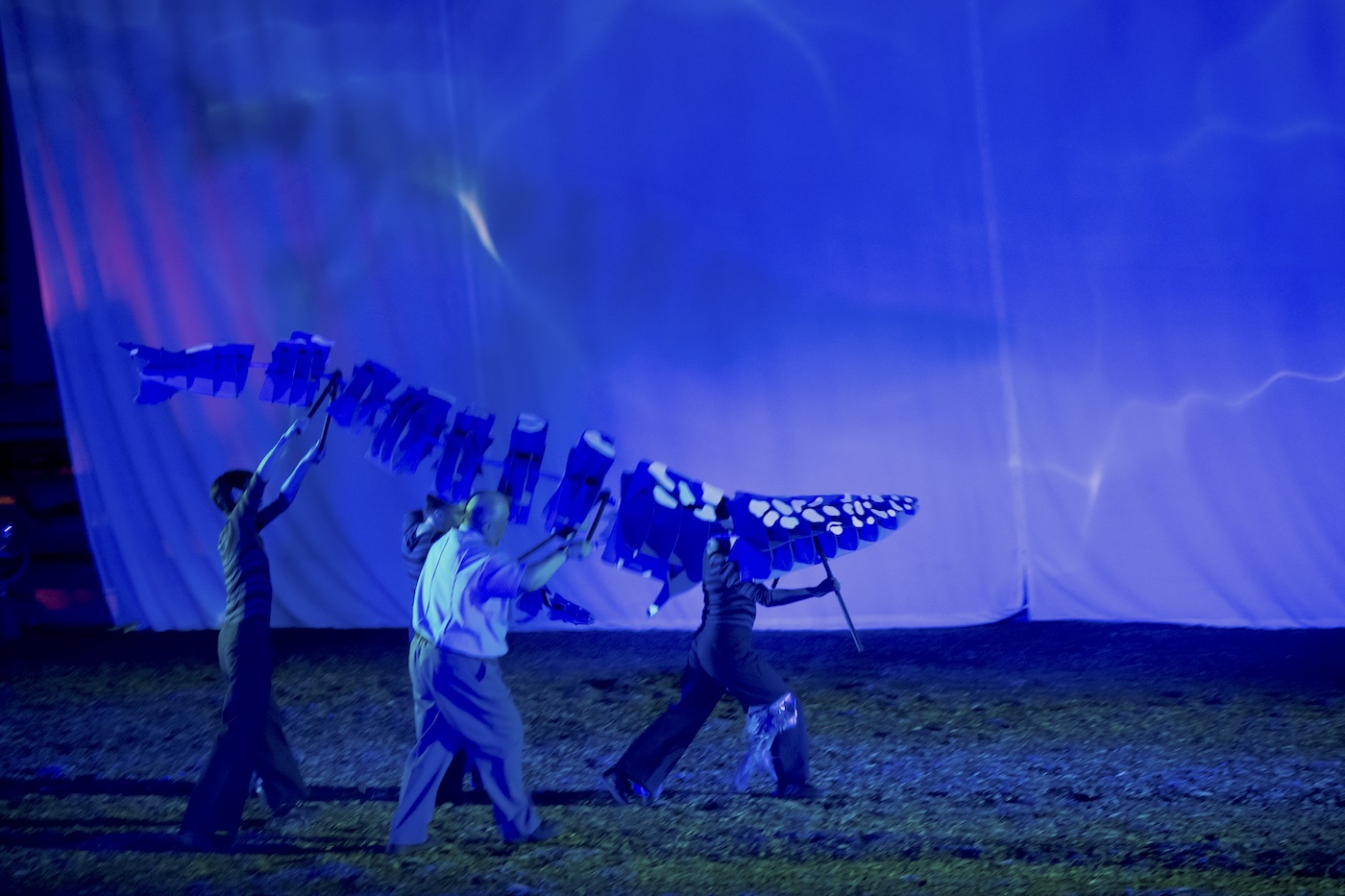
QUOTES FROM PAST WORK
“WOLF was a singular and haunting experience.”
Richard Powers / author of the National Book Award-winning The Echo Maker and the Pulitzer Prize winning The Overstory
“The experience of being … in Deke Weaver’s immersive, magical performance BEAR … is unforgettable — and being there is the point. The feeling of trudging through the park in the dark of night, with the tall grasses brushing your face, the sounds of rustling in the woods, and the sensation of stepping along uneven, muddy, invisible paths all made the fantasy world of BEAR palpably real. We were in it.”
Jonathan Fineberg / Hyperallergic
“Other Animals is a beautiful, quirky, deep show full of Deke’s combination of lyrical storytelling and precisely drawn characters. It’s disturbing and perverse, in the best way.”
Holly Hughes / playwright/performance artist
“Deke Weaver’s Unreliable Bestiary series has a legendary – almost apocryphal – air about it. If you haven’t experienced one, but you’re talking to anyone involved in local art, you’ll hear about it. Usually, there will be some superlatives along with the word ‘indescribable.’ If … you have had a chance to hear Weaver tell a story … you know that this is a special kind of magic that befits his name … know that people aren’t exaggerating when they describe how incredible it is to listen to him.”
Rebecca Knaur / Smile Politely
“Strict categories fail where Weaver is concerned … a delightful, engaging, frequently funny performance, Weaver’s story is especially brilliant.”
Lightsey Darst / MNArtists.org
“2010 wouldn’t be complete without the Art 21 world knowing about this mind-blowing show in a stock pavilion… I don’t know where to begin here, whether it was Deke Weaver’s humor, epic video productions or thoughtfully crafted dance and music by his collaborators, Jennifer Allen and Chris Peck. Weaver’s videos were stunning… Weaver’s style, a layering of live footage, stop-motion animation, projected text and monologue combine to create a sense that there is more to a story than what we see or hear… Allen’s ability to create subtle yet precise differentiations in the dancers’ gestures and formations was remarkable, virtuosic and gritty. The secret of ELEPHANT … is wrapped into a package of video, music, dance and narrative performance that is sensational, entertaining and humorous.”
Marissa Perel / Art 21 Blog
“MONKEY shines in unpredictable ways. … a journey as holy and outrageous as the mythology of Hindu monkey gods or of 1950s Hollywood science fiction, redemption and sacrifice all rolled up like King Kong at the top of the Empire State Building. MONKEY offers a compact, nuggety mindblower…”
P. Gregory Springer / Smile Politely
“What a gift you all made that night! I felt like we shared a wild, vivid dream – strange and resonant.”
Audrey Petty / McSweeney’s editor of High Rise Stories: Voices From Chicago Public Housing
“Weaver’s primary muse is clearly Mark Twain.”
Lawrance Bernabo / Duluth News Tribune
“Garrison Keillor meets Carlos Castaneda in writer-performer Deke Weaver’s cunningly interwoven tales…the magic of the narrative soars…it casts an undeniable spell.”
Brad Rosenstein / San Francisco Bay Guardian
“In a way that only an artist can, Weaver repeatedly undermines the audience’s desire that what they are seeing represents, in the style of old natural-history television, ‘authenticated facts.’ Instead, the artist presents us with what he calls an ‘unreliable bestiary’ — a work which will reclaim a spiritual connection for animals while unmooring the human observer from a world of easily collated zoological facts and taxonomies. In this topsy-turvy slippery world, what we think we know about elephants is jumbled unevenly with science, whimsy, and farce to create an unsettling contemplation of the elephant as an animal we both might know better and will never know at all.”
Nigel Rothfels / “A Hero’s Death” (commentary on ELEPHANT, Animal Acts, co-edited by Una Chaudhuri and Holly Hughes)